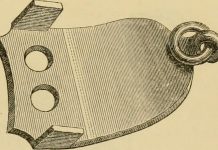The desert warthog (Phacochoerus aethiopicus) is an animal of the Cape Dutch, Vkulubu of the Matabele, and Kolobe of the Bechuanas, and is the most familiar of the wild boars known to the African continent. It has a wide distribution and, in varying forms, is found from northeast Africa to the Cape Colony. The northern (Phacocherus eliant), which naturalists classify as a separate species, differs slightly from the Vlakte vark of South Africa. A full-grown warthog stands between 27 and 30 inches tall at the shoulder. In color, the animal is darkish-brown, tending to be more drab in northern species.
The top of the head and the upper parts of the neck, back, and shoulders are covered with long, stiff bristles. Those at the top of the head radiate a great deal of heat. The wild, ferocious head is disproportionately large, and the muzzle is very broad. The tusks are remarkably large and thick; they stand out wide from the jaw, curving upwards, and are often of surprising length.
A warthog’s great upper tushes are about fifteen to sixteen inches long. Nevertheless, records of great game mention a pair of sharks procured by Captain Berners, R.N., from Annesley Bay, Abyssinia, which both reach extraordinary dimensions of 27 and 26 inches.
The most remarkable feature of this wild desert warthog, from which, of course, it takes its name, lies in the vast fleshy warts or wens that protrude from the face. Of these, the upper and larger grow outside each eye. The lower pair is found between the eye and mouth, not on top of the upper tushes.
The desert warthog flesh, when the animal is fat and in healthy condition, is very nutritious to eat. It forms a not-inconsiderable addition to the hunter’s larder. As a general rule, it may be said that this wild pig is not as formidable an opponent as his relative in India. Often, dogs pursue him and inflict severe wounds on him. In addition to humans, South African hunting ponies have been injured by their tusks.
Spearing wild boar, pursued with zest in India, has never become popular in Africa. However, in the Somalia region, one or two Indian sportsmen have tried their hog spears on these animals. The legations protect wild pigs from sticking around Tangier.
The reason for this is, probably, that the warthog is neither so common nor so easily found as the Indian boar, and that he has a habit of running to the ground when pursued. When a desert warthog returns to earth, which he usually does in the hole of a Cape ant-eater (aardvark), he twists into a warthog. Average Height at shoulder: 28 in. Towards the top of the stern, round, and backs
Two or three men jumping together enthusiastically on the ground above can bolt him after a short interval. In former days, it would seem that the warthog was more commonly found feeding on open plains than now. He is now more often found near well-bushed countries. The hunter in the wilder parts of the interior, however, even today, often gets a fair shot at this pig with his rifle. The warthog can run very fast for a few hundred yards, but a pack of strong, rough dogs or a mounted man can run into him. With clever and plucky dogs who understand their work, this animal provides excellent sport.
A man on foot armed with an assegai or long knife can kill it. Systematic boar hunting is, however, usually done in rounds and in the stern of the forward. Three or four men jumping together on the ground above could bolt him after a short interval. In former days, it would seem that the warthog was more commonly found feeding on open plains than is now the case. He is now more often found in well-bushed countries.
The hunter in the wilder parts of the interior, however, often gets a fair shot at this pig with a rifle. The warthog can go very fast for a few hundred yards, but a pack of strong, rough dogs or a mounted man can run into him. With smart and plucky dogs who understand their work, this animal is a wonderful sport. A man on foot can kill it with a long knife or an assegai. Systematic boar hunting is, however, uncommon in South Africa.
There are very few hunters who kill warthogs, but sometimes they do so in pursuit of other, nobler game in the veldt. When alarmed or excited, the warthog bolts with his family as hard as he can and lays his legs on the ground, his tail held stiffly erect, with the tassel hanging curiously over it.
If he can find a thick bush handy, he will seek shelter there. If very hard-pressed, he will, as shown above, cling to the ground in the nearest earth or hole known to him. When set at bay, he will attack dogs fiercely and inflict severe wounds, and the hunter on foot should approach with caution. More often than not, a rifle bullet puts an end to his defense. If any of the dogs are badly ripped, a stitch or two and an application of weak carbolic and water will usually set matters right. It is rare that a warthog can kill an overplucked or incompetent hound outright with his formidable defense weapons.
The tushes and head of a well-grown desert warthog form a remarkable trophy. It may be noted that the sow of this species carries fine tusks, only marginally smaller than those of the boar. Warthogs are hideous and ferocious, but, save when molested or driven to bay, they are inoffensive. It is shy in its habits and has excellent scent powers, and if the hunter attempts a stalk, it is necessary to take every advantage of the wind.
Read More: Domestic Animals: Donkeys, Cat & Goose






